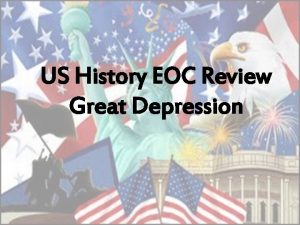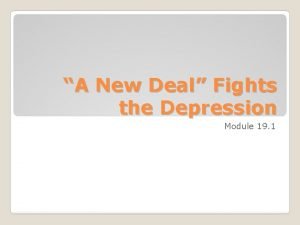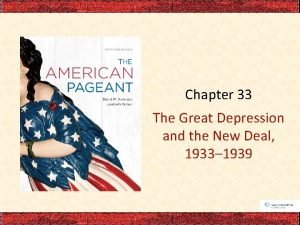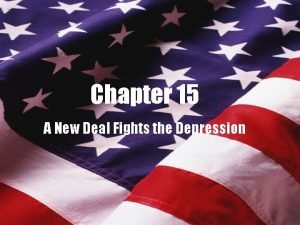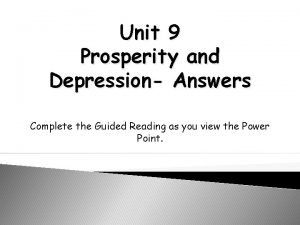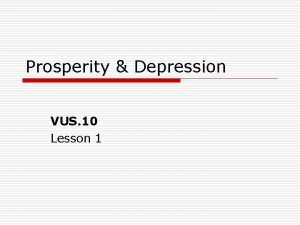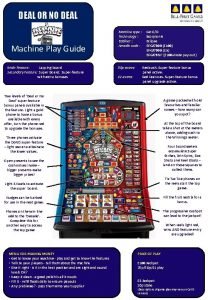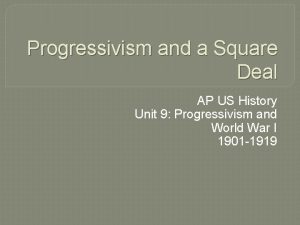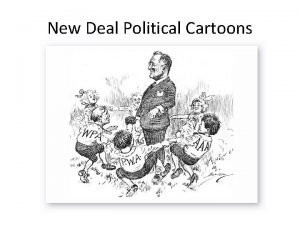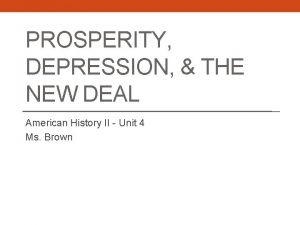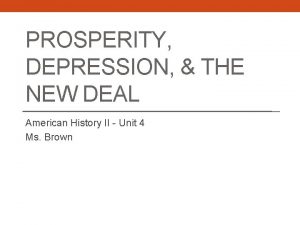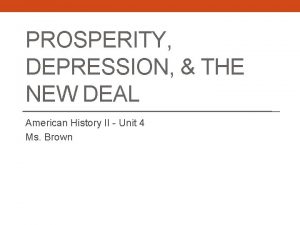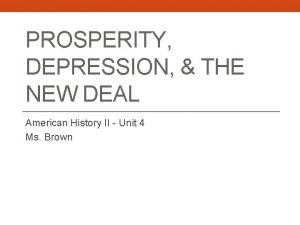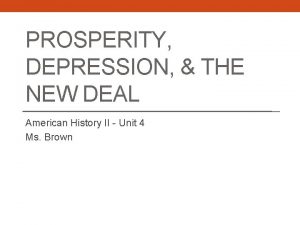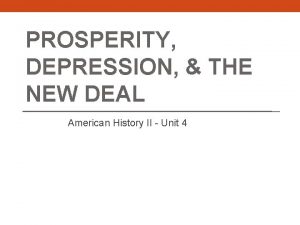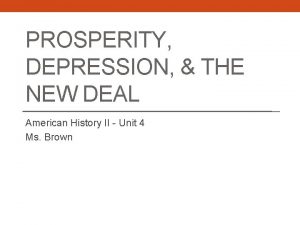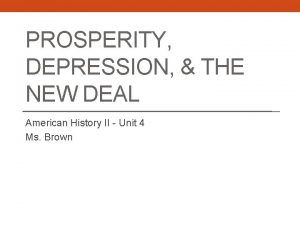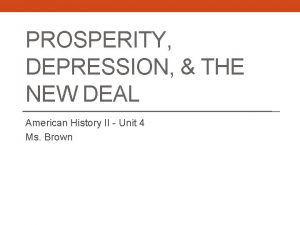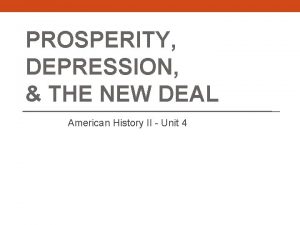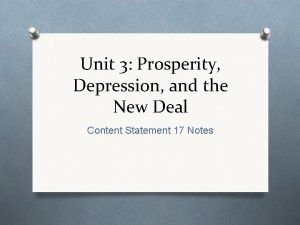PROSPERITY DEPRESSION THE NEW DEAL American History II

















- Slides: 17

PROSPERITY, DEPRESSION, & THE NEW DEAL American History II - Unit 4 Ms. Brown

Review • What was the Great Migration? • 1910 -1930 – mov’t of blacks to northern cities looking for jobs and escaping the Jim Crow South • What did Marcus Garvey encourage blacks in America to do? • Return to Africa, help native people throw off white colonial oppressors, and build independent nations • What was the Harlem Renaissance? • 1920 s literary and artistic mov’t celebrating African American culture • What were themes expressed by artists and authors in during the Harlem Renaissance? • Pride in African American heritage • Emphasized the trials of being black in a white dominated world

4. 5 – CAUSES OF THE GREAT DEPRESSION

4 Main Economic Causes of the Great Depression Decline of key industries Unequal distribution of wealth Great Depression Overuse of credit Farming crisis

Decline of Key Industries • 1920 s - key industries suffered • railroad and steel industries - rise of newer private forms of transportation • coal mining - competition from new forms of energy (hydroelectric power, fuel oil, and natural gas) • late 1920 s - previously booming industries began to decline • automobile - decline in demand production • lumber - decline in lumber demand = weakening housing market (key indicator of economic health)

Farming Crisis • 1920 s - agriculture industry suffered the most • during WWI - farmers took out loans for land equipment to produce food for the war effort • post-WWI - demand fell and crop prices declined by over 40% • Farmers boosted production in hopes of selling more → prices fell more.

Overuse of Credit • End of 1920 s - Americans buying less • rising prices • overproduction of goods • stagnant wages • Increasing number of goods bought on credit - consumers agree to buy now and pay later for goods/services • ex: installment plans • increased consumer debt and decreased spending of actual money

Unequal Distribution of Wealth • 1920 s - rich got richer, poor got poorer • >70% of American families made less than $2, 500/year • most American families could not fully participate in the economic advances of the 1920 s

Election of 1928 • Republican - Herbert Hoover • Sec of Commerce under Harding and Coolidge • never run for public office • quiet and reserved • had the advantage of being in the prosperous 1920 s Republican administrations • Democrat - Alfred E. Smith • 4 term NY governor • open and outgoing • 31 st POTUS = Hoover • Continued “prosperity” with Republicans

The Republican-Democrat Shift Begins… • Smith (Democratic candidate) – Irish Catholic turned off many southern voters who traditionally voted Democratic some voted Republican • Smith’s campaign “supported” civil rights some northern blacks aligned with the Democrats • The issue of civil rights will be more pervasive from this point, and ultimately leads to a shift in party beliefs/platforms.

Investing in the Stock Market • By 1929, Americans still maintained faith in gaining riches through investing in the stock market - the most visible symbol of a prosperous American economy • Dow Jones Industrial Average - a measure of the stock market’s health based on the stock prices of 30 representative large firms on the NY Stock Exchange • barometer of the stock market’s health

Investing in the Stock Market • a stock is a piece of ownership of a company • investors buy stocks and make money when the company makes money • 1920 s - stock prices rose steadily as businesses prospered → DOW high 381 • “bull market” - period of rising stock prices, 3% of Americans owned stocks • rich investors and average Americans hoping to strike it rich

Investing in the Stock Market • Problems with investing in the stock market • speculation - buying stocks on the change of a quick profit while ignoring risks • buying on margin - paying a small percentage of the stock’s price as a down payment and borrowing the rest • unrestrained buying and selling + little gov’t regulation/restrictions = market’s upward growth • Rising prices did not reflect companies actual worth → as the value of stocks declined, people who bought on margin couldn’t pay off loans

Crash of the Stock Market • Early September 1929 - prices peaked and quickly fell → confidence in the stock market started to waver, and some investors quickly sold their stocks • October 29, 1929 - “Black Tuesday” - market dove down, shareholders frantically tried to sell stocks before prices fell further, people who bought stocks on credit were stuck with huge debts, many lost savings • Mid-November 1929 - investors lost about $30 B (how much the US spent in WWI)

The Great Depression • the collapse of the stock market signaled the beginning of the Great Depression - period between 1929 -1940 in which the economy plummeted and unemployment skyrocketed • depression - long-term period of economic decline • recession - a brief period of economic decline

Bank and Business Failures • After the crash, many Americans withdrew money from banks, banks didn’t have enough money to pay withdrawals, banks couldn’t pay back loans taken out to invest in the stock market→ collapse of banks • 1929 -1932 - gross national product (nation’s total output of goods) dropped from $104 M to $59 M • 90, 000 businesses went bankrupt • 25% unemployment, workers faced pay cuts and longer hours

Worldwide Implications • The Great Depression affected Europe as they struggled to pay WWI debts. • The US could no longer import European goods and Europeans could not afford to buy US goods crippled global economy • 1930 – Hawley-Smoot Tariff Act – established the highest protective tariff in US history. • Designed to protect US manufacturers and farmers from foreign competition • Opposite effect: Countries passed similar tariffs in return, American goods not sold abroad, increased unemployment due to loss of European market
 What is the main idea of this cartoon?
What is the main idea of this cartoon? Tennessee valley authority new deal
Tennessee valley authority new deal A new deal fights the depression
A new deal fights the depression Chapter 33 the great depression and the new deal
Chapter 33 the great depression and the new deal The new deal fights the depression
The new deal fights the depression Prosperity and depression worksheet answers
Prosperity and depression worksheet answers Prosperity and depression worksheet answers
Prosperity and depression worksheet answers Deal or no deal machine
Deal or no deal machine Asset deal vs share deal
Asset deal vs share deal Benjamin west contributed a great deal to american art: …
Benjamin west contributed a great deal to american art: … The greatest real estate deal in history
The greatest real estate deal in history Square deal history
Square deal history Square deal definition us history
Square deal definition us history New deal alphabet soup
New deal alphabet soup Chapter 15 section 3 the new deal affects many groups
Chapter 15 section 3 the new deal affects many groups First new deal apush
First new deal apush Aaa new deal purpose
Aaa new deal purpose Fdr new deal political cartoon
Fdr new deal political cartoon
